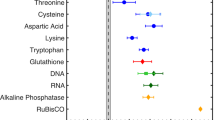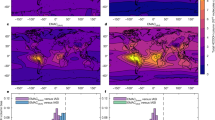Abstract
Hydrogen peroxide, a powerful oxidant, is believed to be a key component in the oxidation of SO2 to H2SO4 in clouds1. The first quantitative H2O2 measurements in snow, rain, hoarfrost and fog were reported in 1874 (ref. 2), however, systematic investigations of H2O2 concentrations in precipitation and hydrometeors began only a few years ago3,4. We report here measurements of hydrogen peroxide in polar ice samples. To our knowledge, chemically-reactive species have not been previously analysed in ice core samples. Our measurements show that H2O2 is a dominant trace compound present in clouds over remote and clean areas.
This is a preview of subscription content, access via your institution
Access options
Subscribe to this journal
Receive 51 print issues and online access
$199.00 per year
only $3.90 per issue
Buy this article
- Purchase on Springer Link
- Instant access to full article PDF
Prices may be subject to local taxes which are calculated during checkout
Similar content being viewed by others
References
Penkett, S. A., Jones, B. M. R., Brice, Y. A. & Eggleton, A. E. J. Atmos. Envir. 13, 123–137 (1979).
Schöne, E. Benchte 7, 1693–1708 (1874).
Kok, G. L. Atmos. Envir. 14, 653–656 (1980).
Zika, R., Saltzmann, E., Chameides, W. L. & Davis, D. D. J. geophys. Res. 87, 5015–5017 (1982).
Klockow, D. & Jacob, P. Proc. NATO Advanced Study Institute, Summer School on Chemistry of Multiphase Atmospheric Systems, Corfu (in the press).
Scott, G. & Seitz, W. R. Analyt. chim. Acta 115, 221–228 (1980).
Herron, M. M., Herron, S. L. & Langway, C. C. Nature 293, 389–391 (1981).
Chameides, W. L. & Davis, D. D. Chem. Engng News 60, 38–52 (1982).
Chameides, W. L. & Davis, D. D. J. geophys. Res. 87, 4863–4877 (1982).
Lal, D. & Peters, B. Handb. Phys. XLVI/2, 551–612 (1967).
Hammer, C. U. J. phys. Chem. 87, 4099–4103 (1983).
Legrand, M. & Delmas, R. J. Atmos. Envir. (in the press).
Fabian, P. & Pruchniewicz, P. G. J. geophys. Res. 85, 2063–2073 (1977).
Raisbeck, G. M. et al. Nature 292, 825–826 (1981).
Beer, J. et al. Radiocarbon 25, 269–278 (1983).
Neftel, A., Oeschger, H., Schwander, J. & Stauffer, B. J. phys. Chem. 87, 4116–4120 (1983).
Neftel, A. et al. Greenland Ice Sheet Program, Philadelphia (American Geophysical Union Monogr., in the press).
Logan, J. A., Prather, M. J., Wofsy, S. C. & McElroy, M. B. J. geophys. Res. 86, 7210–7254 (1981).
Johnsen, S. J. IAHS Publ. No. 118, 210–219 (1977).
Author information
Authors and Affiliations
Rights and permissions
About this article
Cite this article
Neftel, A., Jacob, P. & Klockow, D. Measurements of hydrogen peroxide in polar ice samples. Nature 311, 43–45 (1984). https://doi.org/10.1038/311043a0
Received:
Accepted:
Issue Date:
DOI: https://doi.org/10.1038/311043a0
This article is cited by
-
Characterization of recombinant glutathione reductase from the psychrophilic Antarctic bacterium Colwellia psychrerythraea
Extremophiles (2015)
-
Paleo-Perspectives on Potential Future Changes in the Oxidative Capacity of the Atmosphere Due to Climate Change and Anthropogenic Emissions
Current Pollution Reports (2015)
-
Methods for reactive oxygen species (ROS) detection in aqueous environments
Aquatic Sciences (2012)
-
Ice-core records of global climate and environment changes
Journal of Earth System Science (1998)
-
Measurements of hydrogen peroxide in Antarctic ambient air, snow and firn cores
Fresenius' Journal of Analytical Chemistry (1993)
Comments
By submitting a comment you agree to abide by our Terms and Community Guidelines. If you find something abusive or that does not comply with our terms or guidelines please flag it as inappropriate.



